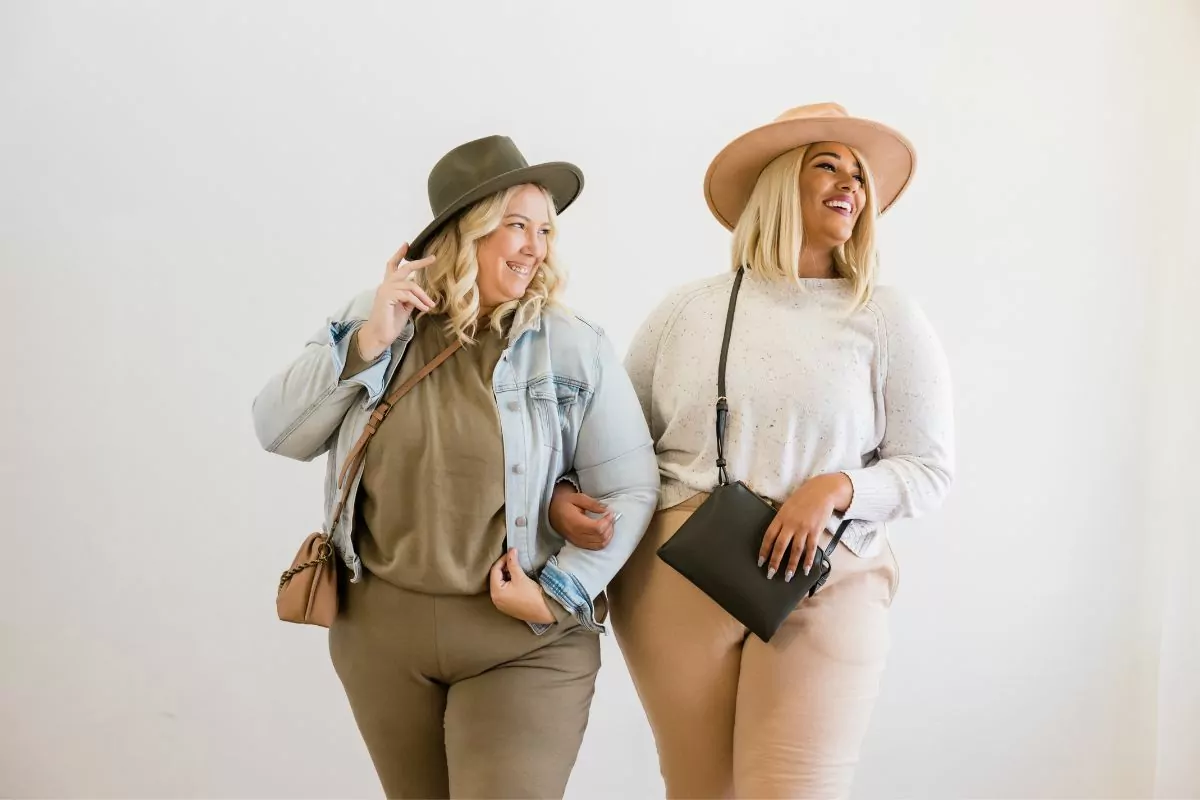Women come in all different shapes and sizes, making it hard to find clothes that fit perfectly. You may even find that you are different sizes in different stores, and these can vary drastically.

In recent years, more and more brands are offering ‘plus size’ clothing collections in a bid to be more inclusive to all customers.
But, what size is considered plus size? Is your usual size going to be found in this section?
This is what we are going to be talking about in this guide, including what size the average American woman is, and what dimensions are plus sized in our US size guide.
Read on to find out!
What Does Plus Size Mean?
Shopping can be so hard as you may not fit society’s idea of an ‘acceptable body’.
There is nothing worse than going into a store as a size 14 or average sized woman with a few curves, and seeing that they do not cater for anything more than a large.
You may have to look in plus size stores or in plus size sections, but what does that mean?
Plus size is the term given to clothing sizes that are larger than the standard range.
Within the fashion industry smaller sizes from 0-14 are considered the norm, and plus sizes can be identified from 16 and over, or 1X all the way up to 7X.
Many stores offer clothing sizes in small, medium and large, with a few offering an XL size.
However, as a plus size woman, these sizes still may not fit curves, and you may need an XXL, 2X, or more for it to be flattering and comfortable.
What Size Is Considered Plus Size?
It is hard to definitively say what size is considered plus size, as many retailers have different clothing sizes as part of this collection.
That being said, in most cases a size 18 or over is considered plus size, whereas sizes 12 and over are considered large.
However, many companies include size 16 as a plus size option. But, all body shapes are different, you could have wider hips or a larger bust that means you have to go up a size, even if you are slim everywhere else.
So, we are going to go through some clothing sizes, see if they are considered plus size, and let you know what sizes you may need to purchase for your body type.
Size 10
If you are a size 10 model, then this is considered bigger than most and curvy by modeling agencies, but let’s face it, a Size 10 is not very big at all.
General fashion is very different from modeling sizes, as modeling agencies want very skinny models to show off the clothes.
A size 10 in general fashion sizes is really far from plus sized. On most sizing charts, a size 10 would be a medium size in most stores.
Size 12
Size 12 is one of the most common sizes that stores carry, because they believe this is inclusive.
It is a sort of middle ground between plus sizes and smaller sizes. That being said, a size 12 woman would probably be a size large in most clothing stores.
However, stores vary, and it depends on the fit you want. Some ‘large’ sizes may not fit some size 12 bodies, and you could opt for a medium for a tighter style or an XL if you want a looser fit.
Size 14
Towards the end of the large clothing scale is a size 14. This is also referred to as a curvy woman, but it often isn’t labeled as ‘plus sized’.
If you were a size 14 model however, you would be considered definitely very plus-size.
A size 14 woman could also fit in a size Large in clothing stores, if she does not have an exceptionally large bust or waist, but an XL could also be beneficial.
Size 16
A size 16 is often the first size available in plus-sized clothing brands.
A size 16 is generally an XL in clothing, which means that you can still get this size in most fashion brands and stores without needing an extra ‘plus sized’ line.
Smaller businesses may not stock this size, but larger companies and big names will typically have size 16 and XL sizes readily available.
However, they often do not stock as many pieces in a size 16 or XL as they would in sizes 10, 12 and 14.
Size 18
A size 18 is usually the beginning of plus size clothing options.
If you are a size 18 in most stores, then you would need to purchase XXL clothing or look for a plus-size section or rack to find clothes that are suitable.
At a size 18, the options are usually limited as most brands are still not as body positive or inclusive as they should be.
Size 20 And Above
Sizes 20, 22 and above are 100% considered plus size.
If you are shopping for clothes and you are a size 20 or above, then you may struggle to find inclusive brands, and the clothes may not fit your body shape.
Everyone has curves in different places, whether you are curvier around the bust, hips, or stomach, so it is best to use your own measurements and the clothing brand’s size guide to see if the clothing would be suitable and comfortable for you!

What Size Is The Average American Woman?
Here is where the issue lies. The Cambridge Dictionary describes plus sized as ‘a size of clothing that is designed for people who are larger than average’. But, the average American woman is actually a size 16 or 18 according to Forbes.
Despite being the ‘average size’, most retailers still label these sizes as plus sized.
This is why so many women struggle to find clothes that fit, as many retailers still only accommodate sizes up to a 12 or 14, and treat those as the ‘norm’, when women are more likely to be a size 16 or more today.
What Size Is A Plus Size Model?
Plus size in the fashion industry and modeling industry is different from the plus size you would find in a store. For instance, plus size models are generally a size 12 or more.
These models are evaluated based on their dress size, rather than their actual body measurements, and can sometimes even be considered ‘plus size’ if they are a size larger than a 6.
That is where the issue often lies, as the ‘plus size’ models wearing the clothes are not really plus sized women.
This can make it harder for you to find clothes that fit your body, as the woman modeling them does not have a similar body shape that you can relate to (Also check out How To Master The Model Off-Duty Look).
Is Size 12 Plus Size?
This is where people often get confused. In modeling agencies and the fashion industry, they favor super skinny models, so a size 12 would be considered plus size to them, but this is not really the case.
In clothing stores and brands, a size 12 would not be considered ‘plus size’ as most women at this size would fit in a regular size Large or even a Medium, depending on their build and the clothing style.
US Size Guide
If you are unsure what size you could be, then check out this size guide that takes your bust, waist and hip measurements into account.
| General Sizing | US Women’s Sizes | Bust (inches) | Waist (inches) | Hips (inches) |
| XS | 0-2 | 32-33 | 24-24 | 34.5-35.5 |
| S | 4-6 | 34-35 | 26-27 | 36-37 |
| M | 8-10 | 36-37 | 28-29 | 38.5-39.5 |
| L | 12-14 | 38.5-40 | 30.5-32 | 41-42.5 |
| XL | 16-18 | 41.5-43 | 33.5-35 | 44-45.5 |
| (Plus)0X | 12 | 40 | 33 | 42 |
| 1X | 14-16 | 42-44 | 34-38 | 44-46 |
| 2X | 18-20 | 46-48 | 39-41 | 48-50 |
| 3X | 22-24 | 50-52 | 43-45 | 52-54 |
| 4X | 26-28 | 54-56 | 47-49 | 56-58 |
| 5X | 30-32 | 58-60 | 51-53 | 60-62 |
Does It Matter If You Are Plus Sized?
The answer to this is tricky, as it does and it doesn’t. Sizing in stores and on clothing is simply just a number, and you shouldn’t worry about it too much.
Some women can be a size 10 in some stores and a 14 in others as it is not consistent across the board.
What matters is that you are healthy. As long as you eat well, exercise often to keep your heart healthy and strong, the number on your clothing does not matter.
Accept your body for the amazing thing that it is, and don’t fixate on the size or shape of it.
It is far better to focus on being healthy, and reducing the risk of diseases such as diabetes and heart disease.
You also have to consider your emotional wellbeing. As long as you are happy and healthy, don’t concern yourself with what size you are picking up in a store!
Summary
To summarize, general sizing in most stores will range from 10, 12, to 14.
A size 16 is often stocked in most stores, but sometimes it is often considered a plus size. Plus sizes are most commonly size 18, 20, 22 and above up to 30.
Sizes 10, 12 and 14 are often labeled as medium to large, whereas 16 – 18 is XL, and 18-20 is XXL or 2X.
- What Is A Figure 8 Body Shape? - June 7, 2023
- How To Dress For Your Body Shape When You’re Plus Size - June 7, 2023
- What Not To Wear With Leggings - June 7, 2023
